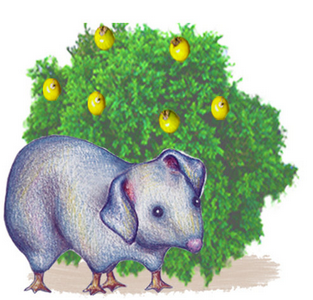Category: CCL
Turn Your Child Into a Science Whiz
 Deborah Kelemen was astonished: in her 2014 study, many five-year-olds and most seven-year-olds grasped the concept of natural selection, a topic usually reserved for teenagers. Thanks to an educational picture book Kelemen helped create about fictional mammals, her study participants (ages five to eight) absorbed the complex biological theory—and even began to apply it to other examples. What other feats of learning, wondered Kelemen, might kids be capable of? With more than $1 million in funding from the National Science Foundation, the professor of psychological & brain sciences and the director of CAS’ Child Cognition Lab is finding out. She shared with arts&sciences what her work reveals about children’s understanding of science—and how parents and teachers can better help them.
Deborah Kelemen was astonished: in her 2014 study, many five-year-olds and most seven-year-olds grasped the concept of natural selection, a topic usually reserved for teenagers. Thanks to an educational picture book Kelemen helped create about fictional mammals, her study participants (ages five to eight) absorbed the complex biological theory—and even began to apply it to other examples. What other feats of learning, wondered Kelemen, might kids be capable of? With more than $1 million in funding from the National Science Foundation, the professor of psychological & brain sciences and the director of CAS’ Child Cognition Lab is finding out. She shared with arts&sciences what her work reveals about children’s understanding of science—and how parents and teachers can better help them.
Click here to read the full article in Boston University’s Arts and Sciences.
CCL Covered in the Times of London!
Research done by the CCL was recently covered in the Times of London. Click the link below to view a PDF of the article!
What’s been happening at the Child Development Labs?
Check out the Child Development Labs' Winter/Spring 2014 newsletter! This newsletter introduces each of our labs, our new Parent Outreach Project initiative, and some of our recent findings! Click here to take a look at our newsletter and find out what your families have helped us discover!
See Jane Evolve: Picture Books Explain Darwin

Evolution by natural selection is one of the best ideas in all of science. It predicts and explains an incredibly wide range of biological facts. But only 60% of Americans believe evolution is true. This may partly be due to religious ideology, of course, but studies show that many secular people who say they believe in evolution still don't really understand it. Why is natural selection so hard to understand and accept? What can we do to make it easier?
Click here to view the full article in the Wall Street Journal
Evolution is Coming to a Storybook Near You
 Young children are notorious for their surfeit of why questions, often directed at aspects of the biological world. Take a three-year-old to the zoo, for example, and you might be asked to explain why zebras have stripes, why elephants have trunks and why flamingos have such skinny legs. (Also: why you can't pet the lion, why another cookie is off limits and why it's really, really time to go home.)
Young children are notorious for their surfeit of why questions, often directed at aspects of the biological world. Take a three-year-old to the zoo, for example, and you might be asked to explain why zebras have stripes, why elephants have trunks and why flamingos have such skinny legs. (Also: why you can't pet the lion, why another cookie is off limits and why it's really, really time to go home.)
Yet this childhood curiosity about the adaptive traits of biological organisms, which Rudyard Kipling recognized with his whimsical "Just So Stories," is all but ignored by current education standards in the United States. It isn't until high school — more than a decade after that curious preschooler wandered the zoo — that children start to learn how natural selection really works.
Are we hard-wired to believe we’re IMMORTAL? Belief that we are eternal is part of human nature and develops during childhood

People across the world, regardless of their religion or culture, believe that humans are immortal, according to research. A new study has shed some light on people’s beliefs that a person's soul or essence transcends the physical body’s death. Scientists think the belief that part of us is eternal emerges early in life and is part of our human nature, rather than something that is imposed on a person by a culture or religion. Researchers from Boston University, led by Natalie Emmons, examined children’s ideas about the time before conception and interviewed 283 children from two very different cultures in Ecuador. Click here to read the article in the Daily Mail
Suicide and the ‘Impure’ Soul
 New research says moral bias against suicide often comes from disgust over a tainted soul.
New research says moral bias against suicide often comes from disgust over a tainted soul.
MATTHEW HUTSON
Around the world, about one million people die of suicide each year, according to the World Health Organization. Each death causes immeasurable harm: Friends, family members, and coworkers suffer loss, guilt, and confusion, and the immediate victim loses a future. Many of those friends and family members consider suicide to be morally wrong. But new evidence shows that people who consider suicide wrong
might have other reasons than the harm it brings. There is a more abstract—and at the same time more visceral—consideration at play.
Click here to read the full article in The Atlantic.
Suicide Widely Deemed Immoral Because It ‘Taints the Soul,’ Study Shows
Suicide is a major public health issue; it takes the lives of more than a million people each year. It is also widely believed to be immoral. Why do people so commonly believe it is wrong for people to take their own lives? According to a study by researchers at Boston College and Boston University, people -- even non-religious people -- make this moral judgment because they believe suicide taints the purity of a person's soul.... Read the full article on Sciencedaily.com
Why Do Giraffes Have Long Necks?

Anyone who has seen this majestic creature in the wild, nibbling away at the top of an acacia tree, has to marvel at the wonder of evolution. The giraffe’s long neck is a perfect adaptation to the animal’s natural habitat. Clearly the giraffe evolved this uncommon and helpful trait in order to reach those nourishing leaves. That’s how natural selection works.
If you’re a 6-year-old.
As appealing as this explanation is, it shows a complete misunderstanding of the concept of adaptation by natural selection, a key concept in the theory of evolution. What’s wrong with the 6-year-old’s idea is not its focus on the neck’s function. It’s the mistaken notion that an individual giraffe, by its own effort and action, can transform its essential nature in a beneficial way.
Read the full article at psychologicalscience.org
The Natural Design Default
Scientists pride themselves on the diamond-hard discipline of the objective observer, yet a recent study suggests that despite years of training, some of the most highly regarded researchers in the country can’t escape a deep-seated belief that natural phenomena exist for a purpose.


